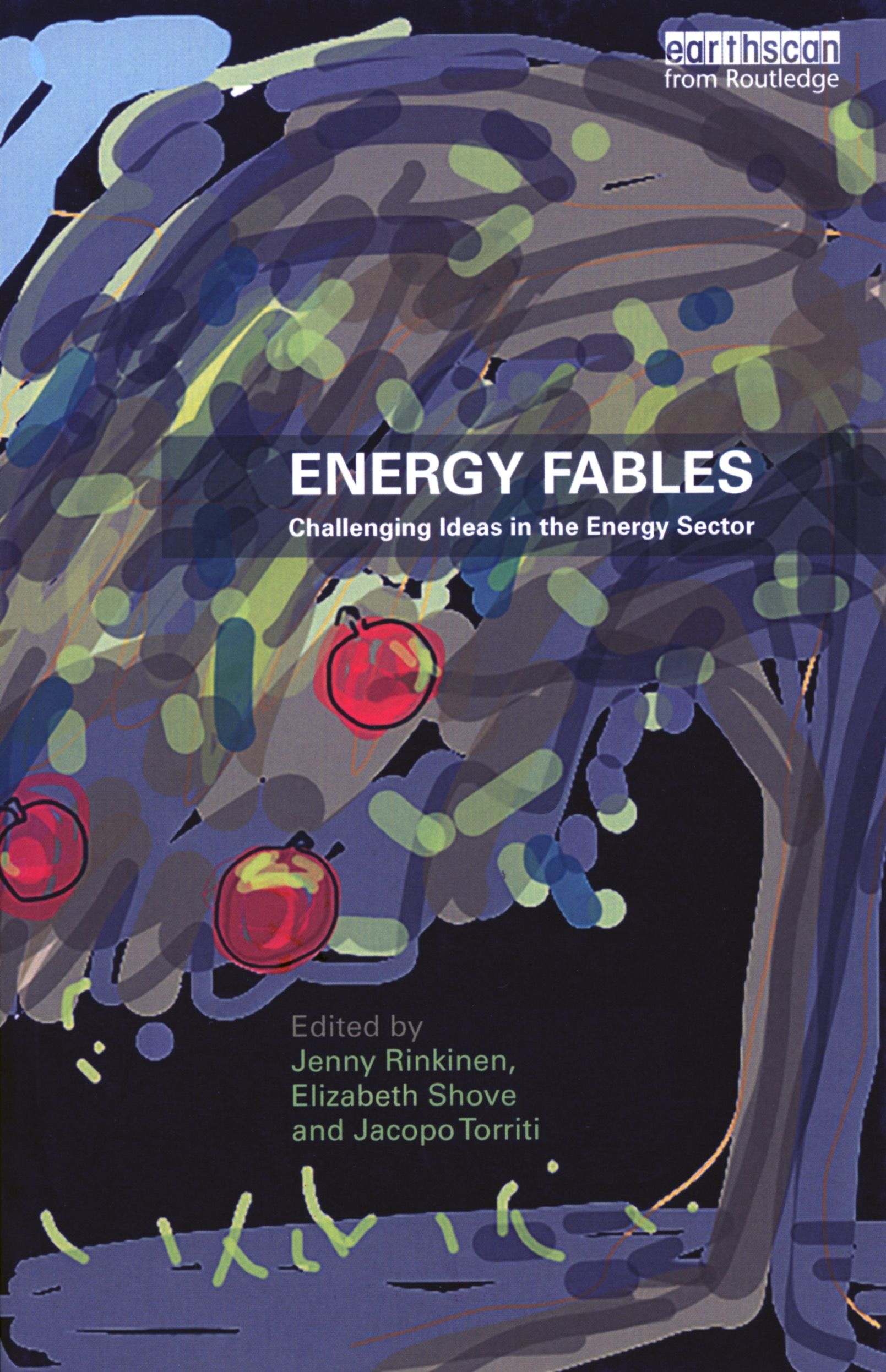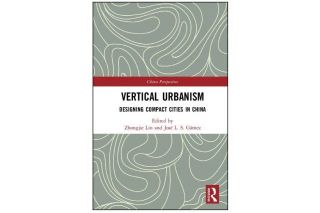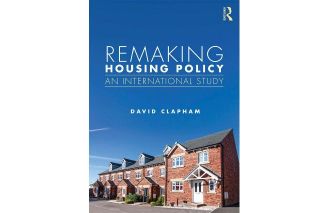
www.buildingsandcities.org/insights/reviews/energy-fables-challenging-ideas-energy-sector.html
Energy Fables: Challenging Ideas in the Energy Sector
Edited by Jenny Rinkinen, Elizabeth Shove, and Jacopo Torriti. Routledge, 2019, ISBN: 9780367027797.
 Mithra Moezzi (QQForward) applauds this short,
powerful book for revealing how many current energy discourses are framed
and their limitations. The authors provide constructive, inspiring
approaches that will help us to better understand and reframe energy practices,
research and policies.
Mithra Moezzi (QQForward) applauds this short,
powerful book for revealing how many current energy discourses are framed
and their limitations. The authors provide constructive, inspiring
approaches that will help us to better understand and reframe energy practices,
research and policies.
Energy Fables sees the energy efficiency profession as being guided by a constellation of shared concepts, words, and short stories "worn smooth through use and submerged within familiar discourses in government, and well as in research and teaching" (p. 1). These are building blocks of communication, problem definition, and solutions in the field, creating "fables" that "sustain and reproduce a body of ideas about what is normal and about what drives change" (p. 124). As the problems addressed by the profession continue to expand from achieving energy efficiency as defined in the past to the much larger scale and ambitions of climate change policy, the authors argue, limitations of these traditional concepts have become clearer and more consequential.
Eleven example fables are taken on in this edited volume. Each gets its own chapter, none longer than ten pages. The chapters are readable separately versus a full read of the book. The collection begins with how fundamentals (energy demand, energy efficiency, and energy services) are defined and deployed. It then turns to ideas about energy dynamics (rebound, elasticity) and to common "injunctions" ("keep the lights on," "pick the low hanging-fruit," and promote Smart Homes) and finally to broad policy themes (the energy trilemma, flexibility, and focus on energy versus non-energy policy as the main vehicle for influencing change). An introduction and postscript bracket the fable chapters. As seen in a traditional concept of folklore, these fables reinforce existing culture while also serving as devices for debate.
Each fable is analyzed to reveal aspects of the worldview it reflects and as to how it directs policy and research. From there, the authors challenge the fable and directions it carries regarding energy problems, and then suggest the beginnings of new approaches and perspectives that edge past current limitations to better serve climate change policy. For example, the term "rebound" brings with it the idea of bouncing off a hypothetical hard world where a new technology would have no impact on the energy services demanded, with a bounce-back representing recovery of part of the value of this efficiency via increased levels of energy services (p. 40). Despite research attention to nailing down estimates of rebound effects, measurability issues keep these exercises limited. While those estimates can still be useful, chapter author Greg Marsden argues, rather than remaining bogged down by inherent limitations of rebound estimation, a next move is opened up by recognizing that rebound is an incomplete expression of the effects of any new technology. For some readers, the moves highlighting new approaches or perspectives throughout the chapters may appear subtle. And the authors do not intend to be prescriptive. Bit by bit, however, these ventures outside conventional terms of debate inject permeability into existing energy efficiency professional culture and give glimpses of something promising and new.
Beyond the analyses of the specific topics covered, one ideal outcome of this book would be for readers throughout the energy efficiency profession to realize the folkloric (and "false") nature of many phrases and concepts of the field. These could then be seen not just as convenient communication standards or reflections of the immediate problems faced (e.g. "get people to adopt this technology"), but as gateways shaping what is assumed, how problems are defined, and what is visible, invisible, disallowed, or out of scope.
An outstanding aspect of this book is that it is designed to be read: compact (130 pp.), straightforward writing and easy to parse. This makes it accessible to a wide range of readers, including policymakers, advanced postgraduate students, and energy professionals from various disciplines who could keep it and share it as a reference book. Energy social scientists will likely be familiar with parts of many of these arguments, but the slim collection is convenient and could easily inspire broader conversations across disciplines or roles. Aiding such conversations, the book does not have a critical tone but a matter of fact one, with a clear recognition that fables are not just matters of individual commitments and convictions.
The final chapter is a powerful summary of where this leaves us. Policymakers and researchers can probably not "change their spots" quickly, the editors note. Rather, current fables are a default set of shared (though not universally believed or embraced) understandings built into everyday work and group culture, held into place by many factors -politics, markets, quantitative models, funding and reporting templates and formulae, the need for measurability, etc. While acknowledging these difficulties, this book takes an important step in encouraging more open conversations about the conflicts these fables highlight and the possibilities for adapting energy work to new scientific and practical challenges and possibilities.
Latest Peer-Reviewed Journal Content
Simulation and the building performance gap [editorial]
M Donn
Developing criteria for effective building-sector commitments in nationally determined contributions
P Graham, K McFarlane & M Taheri
Reimagining circularity: actions for optimising the use of existing buildings
R Lundgren, R Kyrö, S Toivonen & L Tähtinen
Effective interdisciplinary stakeholder engagement in net zero building design
S Vakeva-Baird, F Tahmasebi, JJ Williams & D Mumovic
Metrics for building component disassembly potential: a practical framework
H Järvelä, A Lehto, T Pirilä & M Kuittinen
The unfitness of dwellings: why spatial and conceptual boundaries matter
E Nisonen, D Milián Bernal & S Pelsmakers
Environmental variables and air quality: implications for planning and public health
H Itzhak-Ben-Shalom, T Saroglou, V Multanen, A Vanunu, A Karnieli, D Katoshevski, N Davidovitch & I A Meir
Exploring diverse drivers behind hybrid heating solutions
S Kilpeläinen, S Pelsmakers, R Castaño-Rosa & M-S Miettinen
Urban rooms and the expanded ecology of urban living labs
E Akbil & C Butterworth
Living with extreme heat: perceptions and experiences
L King & C Demski
A systemic decision-making model for energy retrofits
C Schünemann, M Dshemuchadse & S Scherbaum
Modelling site-specific outdoor temperature for buildings in urban environments
K Cebrat, J Narożny, M Baborska-Narożny & M Smektała
Understanding shading through home-use experience, measurement and modelling
M Baborska-Narożny, K Bandurski, & M Grudzińska
Building performance simulation for sensemaking in architectural pedagogy
M Bohm
Beyond the building: governance challenges in social housing retrofit
H Charles
Heat stress in social housing districts: tree cover–built form interaction
C Lopez-Ordoñez, E Garcia-Nevado, H Coch & M Morganti
An observational analysis of shade-related pedestrian activity
M Levenson, D Pearlmutter & O Aleksandrowicz
Learning to sail a building: a people-first approach to retrofit
B Bordass, R Pender, K Steele & A Graham
Market transformations: gas conversion as a blueprint for net zero retrofit
A Gillich
Resistance against zero-emission neighbourhood infrastructuring: key lessons from Norway
T Berker & R Woods
Megatrends and weak signals shaping future real estate
S Toivonen
A strategic niche management framework to scale deep energy retrofits
T H King & M Jemtrud
Generative AI: reconfiguring supervision and doctoral research
P Boyd & D Harding
Exploring interactions between shading and view using visual difference prediction
S Wasilewski & M Andersen
How urban green infrastructure contributes to carbon neutrality [briefing note]
R Hautamäki, L Kulmala, M Ariluoma & L Järvi
Implementing and operating net zero buildings in South Africa
R Terblanche, C May & J Steward
Quantifying inter-dwelling air exchanges during fan pressurisation tests
D Glew, F Thomas, D Miles-Shenton & J Parker
Western Asian and Northern African residential building stocks: archetype analysis
S Akin, A Eghbali, C Nwagwu & E Hertwich



Latest Commentaries
Building-Related Research: New Context, New Challenges
Raymond J. Cole (University of British Columbia) reflects on the key challenges raised in the 34 commissioned essays for Buildings & Cities 5th anniversary. Not only are key research issues identified, but the consequences of changing contexts for conducting research and tailoring its influence on society are highlighted as key areas of action.
Lessons from Disaster Recovery: Build Better Before
Mary C. Comerio (University of California, Berkeley) explains why disaster recovery must begin well before a disaster occurs. The goal is to reduce the potential for damage beforehand by making housing delivery (e.g. capabilities and the physical, technical and institutional infrastructures) both more resilient and more capable of building back after disasters.